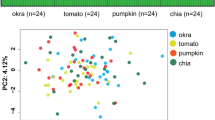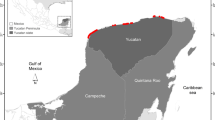Abstract
Bemisia tabaciis a complex of closely related genetic types of whiteflies, few of which are invasive. One of these, B biotype, has proven to be particularly adapted to invading new areas, but the underlying reasons as to why it has a well-developed capacity to invade is not known. To develop an understanding of factors that may be contributing to B’s invasive capacity, inter-biotype mating interactions and host plant suitability for the exotic B (B. tabaci Mediterranean/Asia Minor/Africa) and the indigenous Australian (AN) biotype (B. tabaci Australia) were examined. The results suggest that when confined to a mutually acceptable host, B cannot establish when the ratio of AN : B exceeds 20 : 1. However, when simultaneously provided with a host that only it prefers, B is able to establish even at 50 : 1 (AN : B). Further, when both biotypes occur together the number of progeny per female increases (relative to the number produced when only one biotype is present). The response is observed for both biotypes, but is considerably greater in the case of B. In addition, B performs better in the presence of the AN biotype B. tabaci Australia while AN perform worse in coexistence with B, but only if the demographics allow B to mate without significant interference. This leads to the prediction that B will invade in circumstances where its unique hosts are of sufficient number to escape the full negative impact of inter-biotype mating interactions and reduced competitiveness in terms of reproductive rate, while exposing the indigenous biotype to the full effects of the interaction.
Similar content being viewed by others
Abbreviations
- DNA:
-
polymerase chain reaction
- RAPD-PCR:
-
random amplified polymorphic
References
AA Agrawal MF Sherriffs (2001) ArticleTitleInduced plant resistance and susceptibility to late-season herbivores of wild radish Annals of the Entomological Society of America 94 71–75
S Alla JP Moreau B Frerot (2001) ArticleTitleEffects of the aphid Rhopalosiphum padi on the leafhopper Psammotettix alienus under laboratory conditions Entomologia Experimentalis et Applicata 98 203–209 Occurrence Handle10.1023/A:1018951310845
GK Banks J Colvin RV Chowda Reddy MN Maruthi V Muniyappa HM Venkatesh MK Kumar AS Padmaja FJ Beitia SE Seal (2001) ArticleTitleFirst report of the Bemisia tabaci B biotype in India and an associated tomato leaf curl virus disease epidemic Plant Disease 85 231
M Burstein D Wool A Eshel (1994) ArticleTitleSink strength and clone size of sympatric, gall-forming aphids European Journal of Entomology 91 57–61
De Barro PJ (1995). Bemisia tabaci biotype B: a review of its biology, distribution and control. CSIRO Technical Paper No 36, pp 58 (second Edition)
PJ Barro ParticleDe F Driver (1997) ArticleTitleUse of RAPD PCR to distinguish the B biotype from other biotypes of Bemisia tabaci (Gennadius) (Hemiptera: Aleyrodidae) Australian Journal of Entomology 36 149–152
PJ Barro ParticleDe PJ Hart (2000) ArticleTitleMating interactions between two biotypes of the whitefly, Bemisia tabaci (Hemiptera: Aleyrodidae) in Australia Bulletin of Entomological Research 90 103–112 Occurrence Handle10948369
PJ Barro ParticleDe F Driver JWH Trueman J Curran (2000) ArticleTitlePhylogenetic relationship of world populations of Bemisia tabaci (Gennadius) using ribosomal ITS1 Molecular Phylogenetics and Evolution 16 29–36 Occurrence Handle10877937
PJ Barro ParticleDe JWH Trueman DR Frohlic (2005) ArticleTitleBemisia argentifolii is a population of B. tabaci, the molecular genetic differentiation of B. tabaci populations around the world Bulletin of Entomological Research 95 1–11
M Fisher (1986) ArticleTitleThe effect of previously infested spruce needles on the growth of the green spruce aphid, Elatobium abietinum, and the effect of the aphid on the amino acid balance of the host plant Annals of Applied Biology 111 33–41
DR Frohlich I Torres-Jerez ID Bedford PG Markham JK Brown (1999) ArticleTitleA phylogeographical analysis of the Bemisia tabaci species complex based on mitochondrial DNA markers Molecular Ecology 8 1683–1691 Occurrence Handle10583831 Occurrence Handle10.1046/j.1365-294x.1999.00754.x
AC Gange VK Brown (1989) ArticleTitleEffects of root herbivory by an insect on a foliar-feeding species, mediated through changes in the host plant Oecologia 81 38–42 Occurrence Handle10.1007/BF00377007
JA Gatehouse (2002) ArticleTitlePlant resistance towards insect herbivores: a dynamic interaction New Phytologist 156 145–169 Occurrence Handle10.1046/j.1469-8137.2002.00519.x Occurrence Handle1:CAS:528:DC%2BD38XovFGru74%3D
DR Jimenez RK Yokomi RT Mayer JP Shapiro (1995) ArticleTitleCytology and physiology of silverleaf whitefly-induced squash silverleaf Physiological and Molecular Plant Pathology 46 227–242
NAC Kidd GB Lewis CA Howell (1985) ArticleTitleAn association between two species of pine aphid, Schizolachnus pineti and Eulachnus agilis Ecological Entomology 10 427–432
KC Larson TG Whitham (1991) ArticleTitleManipulation of food resources by a gall-forming aphid: the physiology of sink–source interactions Oecologia 88 15–21 Occurrence Handle10.1007/BF00328398
TY Li SB Vinson D Gerling (1989) ArticleTitleCourtship and mating behaviour of Bemisia tabaci(Homoptera: Aleyrodidae) Environmental Entomology 18 800–806
RT Mayer TG McCollum RE McDonald JE Polston H Doostar (1996) Bemisia feeding induces pathogenesis-related proteins in tomato D Gerling RT Mayer (Eds) Bemisia: 1995. Taxonomy, Biology, Damage, Control and Management Intercept Ltd Andover, UK 179–188
RT Mayer M Inbar CL Mckenzie R Shatters V Borowicz U Albrecht CA Powell H Doostdar (2002) ArticleTitleMultitrophic interactions of the silverleaf whitefly, host plants, competing herbivores, and phytopathogens Archives of Insect Biochemistry and Physiology 51 151–169 Occurrence Handle12432517 Occurrence Handle10.1002/arch.10065 Occurrence Handle1:CAS:528:DC%2BD38Xptleju7Y%3D
FJ Messina R Taylor ME Karren (2002) ArticleTitleDivergent responses of two cereal aphids to previous infestation of their host plant Entomologia Experimentalis et Applicata 103 43–50 Occurrence Handle10.1023/A:1019836202446
NA Moran TG Whitham (1990) ArticleTitleInterspecific competition between root-feeding and leaf-galling aphids mediated by host-plant resistance Ecology 71 1050–1058
S Pascual C Callejas (2004) ArticleTitleIntra- and interspecific competition between biotypes B and Q of Bemisia tabaci (Hemiptera: Aleyrodidae) from Spain Bulletin of Entomological Research 94 369–375 Occurrence Handle15301702 Occurrence Handle10.1079/BER2003307 Occurrence Handle1:STN:280:DC%2BD2czpvVShtw%3D%3D
TM Perring (2002) ArticleTitleThe Bemisia tabaci species complex Crop Protection 20 725–737
MK Petersen JP Sandstrom (2001) ArticleTitleOutcome of indirect competition between two aphid species mediated by responses in their common host plant Functional Ecology 15 525–534 Occurrence Handle10.1046/j.0269-8463.2001.00552.x
D Simberloff B Holle ParticleVon (1999) ArticleTitlePositive interactions of nonindigenous species: invasional meltdown? Biological Invasions 1 21–32 Occurrence Handle10.1023/A:1010086329619
MJ Stout AL Fidantsef SS Duffey RM Bostock (1999) ArticleTitleSignal interactions in pathogen and insect attack: systemic plant-mediated interactions between pathogens and herbivores of the tomato, Lycopersicon esculentum Physiological and Molecular Plant Pathology 54 115–130 Occurrence Handle10.1006/pmpp.1998.0193 Occurrence Handle1:CAS:528:DyaK1MXisVOntrY%3D
JS Thaler MJ Stout R Karban SS Duffey (2001) ArticleTitleJasmonate-mediated induced plant resistance affects a community of herbivores Ecological Entomology 26 312–324 Occurrence Handle10.1046/j.1365-2311.2001.00324.x
JS Thaler R Karban DE Ullman K Boege RM Bostock (2002) ArticleTitleCross-talk between jasmonate and salicylate plant defense pathways: effects on several plant parasites Oecologia 131 227–235
NC Underwood (1998) ArticleTitleThe timing of induced resistance and induced susceptibility in the soybean-Mexican bean beetle system Oecologia 114 376–381 Occurrence Handle10.1007/s004420050460
WTG Ven Particlevan de CS LeVesque TM Perring LL Walling (2000) ArticleTitleLocal and systemic changes in squash gene expression in response to silverleaf whitefly feeding Plant Cell 12 1409–1423 Occurrence Handle10948259
LL Walling (2000) ArticleTitleThe myriad plant responses to herbivores Journal of Plant Growth Regulation 19 195–216 Occurrence Handle11038228 Occurrence Handle1:CAS:528:DC%2BD3cXnvF2hu7w%3D
Author information
Authors and Affiliations
Corresponding author
Rights and permissions
About this article
Cite this article
De Barro, P.J., Bourne, A., Khan, S.A. et al. Host Plant and Biotype Density Interactions – Their Role in the Establishment of the Invasive B Biotype of Bemisia tabaci. Biol Invasions 8, 287–294 (2006). https://doi.org/10.1007/s10530-005-1261-6
Received:
Accepted:
Issue Date:
DOI: https://doi.org/10.1007/s10530-005-1261-6




